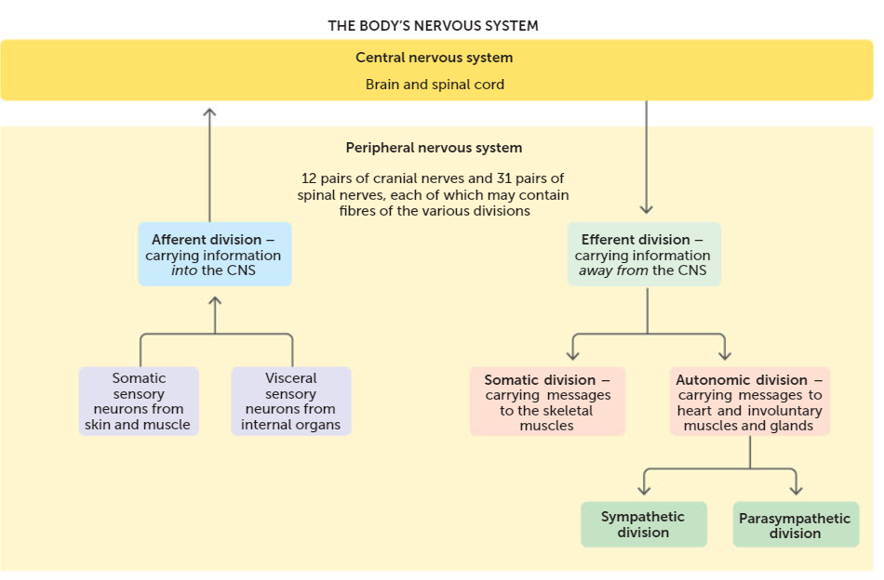Peripheral Nervous System Overview
1/19
Earn XP
Description and Tags
A comprehensive set of flashcards covering key concepts of the Peripheral Nervous System and its components.
Name | Mastery | Learn | Test | Matching | Spaced |
|---|
No study sessions yet.
20 Terms
What does the Peripheral Nervous System (PNS) consist of?
The PNS consists of nerves and ganglia outside of the brain and spinal cord.) it connects the Central Nervous System (CNS) to the limbs and organs.
Neuron Types and Pathways
Sensory Neurons (Afferent): Transmit sensory information to the CNS.
Interneurons: Process information within the CNS.
Motor Neurons (Efferent): Carry commands from CNS to muscles and glands.
what nerves connect pns to cns
Cranial Nerves: These originate from the brain (specifically the brainstem) and connect the head and neck to the CNS. They can be sensory (afferent), motor (efferent), or mixed (both sensory and motor).
Spinal Nerves: These arise from the spinal cord and connect the rest of the body to the CNS. Most spinal nerves are mixed nerves, carrying both sensory (afferent) and motor (efferent) information.
What is the function of efferent (motor) neurons?
The function of efferent (motor) neurons is to carry motor commands from the CNS (Central Nervous System) to muscles and glands throughout the body. This allows the body to carry out actions such as muscle movement (voluntary and involuntary) and the secretion of substances by glands. Essentially, efferent neurons enable the body to respond to signals from the brain and spinal cord, facilitating movement, reflexes, and other motor functions.
What does the autonomic nervous system control?
Function: Controls the body's internal environment and maintains homeostasis. is involuntary, send nerve impulses to various internal organs to regulate involuntary functions.
Regulation: Operates without conscious control through groups of nerve cells in the medulla oblongata, hypothalamus, and cerebral cortex. (includes; blood pressure, body temp, digestion, energy release, pupil, diameter, airflow lungs, defecation + urination.
What is the primary role of the somatic nervous system?
It controls voluntary motor output of skeletal muscle contraction.
function of sympathetic NS division
Facilitates responses that prepare the body for strenuous activity; often referred to as 'fight or flight'.
Uses noradrenalin as a neurotransmitter. Uses lumbar nerves
What does the parasympathetic division do?
Maintains body systems during calm conditions; often referred to as 'rest and digest'.
Uses acetylcholine as a neurotransmitter. Uses cranio-sacral nerves
How many pairs of cranial nerves are there?
There are 12 pairs of cranial nerves.
What is the cauda equina?
A mass of spinal nerves that occupies the vertebral foramen below the 2nd lumbar vertebra.
What happens at the dorsal root of a mixed spinal nerve?
It carries afferent (sensory) fibers and contains a dorsal root ganglion. carries sensory information from the body (such as touch, temperature, and pain) towards the spinal cord and then to the brain. The dorsal root contains afferent (sensory) nerve fibers.
difference between autonomic and somatic NS
Pathway:
ANS involves two motor neurons; SNS involves one.
Neurotransmitters:
ANS can use acetylcholine or noradrenaline; SNS primarily uses acetylcholine.
Control:
ANS is usually involuntary; SNS is usually voluntary.
Effectors:
ANS targets involuntary muscles and glands; SNS targets skeletal muscles.
How many pairs of spinal nerves are there?
There are 31 pairs of spinal nerves.
NS divisions:
Central-Peripheral: CNS (brain and spinal cord) vs PNS (nerves outside CNS).
Afferent-Efferent: Afferent (sensory) neurons bring impulses to CNS, while efferent (motor) neurons carry impulses away from CNS.
Autonomic-Somatic: Autonomic (involuntary control) vs somatic (voluntary control) functions.
Sympathetic-Parasympathetic: Sympathetic prepares body for fight or flight; parasympathetic maintains normal body functions.
dirrection of Nerves from PNS to CNS:

What type of responses does the parasympathetic division produce?
Responses that maintain the body during relatively quiet conditions.
What happens to heart rate during sympathetic stimulation?
Heart rate increases as part of the 'fight or flight' response.
What part of the nervous system controls voluntary muscle movement?
The somatic division of the PNS.
What are the effectors controlled by the autonomic division?
Heart muscle, involuntary muscle, and glands.
how do sensory neurons impuses transfer into motor neuron impulses
Sensory neurons carry impulses from sensory receptors (such as skin, eyes, or ears) to the CNS (Central Nervous System), providing information about stimuli like touch, temperature, or pain. Within the CNS, interneurons process and integrate this sensory information, acting as a link between sensory input and motor output. The processed information is then transmitted to motor neurons, which carry the signals from the CNS to muscles or glands, prompting a response such as muscle movement or gland secretion.